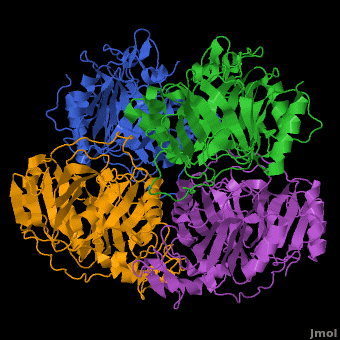Dioxygenases cleave the aromatic rings of their substrates by inserting two oxygen atoms, thus degrading these compounds. The dioxygenases are divided into 2 groups according to their mode of ring scission. The intradiol enzymes use Fe+3 as cofactor and cleave the substrate between 2 hydroxyl groups. The extradiol enzymes use Fe+2 as cofactor and cleave the substrate between a hydroxylated carbon and a non-hydroxylated one.
- Protocatechuate 3,4-dioxygenase (PCD), belongs to the intradiol family and catalyzes the oxygenation of dihydroxybenzoate (DHB) to 3-carboxy-muconate. PCD participates in the aromatic compound benzoate degredation and uses Fe as cofactor. PCD consists of 8 subunits each containing an Fe and a substrate binding site. Each of these subunits is composed of α and β chains. Hydroxyphenyl acetate is an inhibitor of PCD.
- Catechol 1,2-dioxygenase (CTD) cleaves the ring of catechol by insertion of 2 oxygen atoms to form muconic acid.
- Homoprotocatechuate 3,4-dioxygenase (HPCD), an extradiol cleaving enzyme cleaves the aromatic ring of its substrate, adds 2 oxygen atoms to form α-hydroxy-δ carboxymethyl muconic semialdehyde.
- Naphthalene 1,2-dioxygenase (NDO) catalyzes the conversion of naphthalene and O2 to dihydronaphthalene-diol.
- Glyoxalase/bleomycin resistant protein/dioxygenase (GBD) catalyzes the cleavage of S-lactoyl-glutathione to methylglyoxal and glutathione.
- α-ketoglutarate-dependent dioxygenase homolog 5 (Alkbh5) is an RNA demethylase which reverses the N(6)-methyladenosine modification of RNA.
A Hyperactive Cobalt-Substituted Extradiol-Cleaving Catechol Dioxygenase [1]
In most metalloenzyme mechanisms, O2 is reductively activated by direct electron transfer from the reduced metal ion. This implies that the rate of the reaction should be strongly dependent on the redox potential of the catalytic metal. We have proposed a different strategy for the Fe(II)-containing extradiol aromatic ring-cleaving dioxygenase family in which the activating electron is derived from the aromatic substrate rather the iron. When the aromatic substrate and the O2 are bound to the metal at the same time, the metal may serve as a conduit for the activating electron. Since there is no net change in metal oxidation state during this process, the impact of the redox potential of the metal on oxygen activation should be minimal, so long as it is low enough to allow formation of the initial O2 complex. This hypothesis is tested here by substituting Co(II) for Fe(II) in the (2,3-HPCD) from Brevibacterium fuscum.
2,3-HPCD catalyzes the cleavage of the C2-C3 bond of homoprotocatechuate (HPCA) with the incorporation of both oxygen atoms derived from O2 to form ring opened, 5-carboxymethyl-2-hydroxymuconic semialdehyde (5-CHMSA). Despite the significantly higher standard redox potential of Co(III/II) (1.92 V versus SHE) relative to that of the native metal Fe(II) (0.77 V), Co-HPCD was found to have more than twice the specific activity of Fe-HPCD under saturating O2 conditions, making Co-HPCD a hyper-active enzyme. The presence of is illustrated by the 4 strong anomalous difference peaks determined from the X-ray diffraction data set collected at the cobalt K-edge (Figure 4A, 1.6050 Å, 7.725 keV), which shows cobalt coordinated via . The structural comparison of the high-resolution X-ray crystal structures of Fe-HPCD (1.70 Å, 3ojt), Mn-HPCD (1.65 Å, 3ojn), and Co-HCPD (1.72 Å, 3ojj) shows environment as indicated by the RMSD values of 0.10-0.14 Å for superposition of . In addition, the presence of Co in the active site of HPCD has on either the or on the conformational integrity of the active site residues in. The absence of any observable structural differences upon metal substitutions suggests that differential redox tuning of the metal centers in this dioxygenase is highly unlikely. Rather, the 2,3-HPCD enzyme can carry out the O2 activation and oxidative ring-cleavage efficiently over a large range of metal redox potentials. The structural analysis supports the proposed mechanism described above in which the ability of the enzyme to activate molecular O2 does not correlate with redox potential of the metal center. However, the current results also show that the rates of individual steps in the overall catalytic cycle can be effected by the metal present in the active site of HPCD, resulting in a earlier rate-limiting step for Co-HPCD compared to Fe-HPCD and Mn-HPCD.

